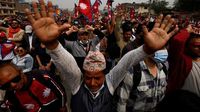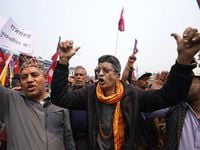KATHMANDU, Apr 20: On Sunday, April 20, 2025, hundreds of supporters of the pro-monarchist Rastriya Prajatantra Party (RPP) staged a protest near the high-security zone that houses the Prime Minister's residence and the Parliament in Kathmandu. This demonstration was aimed at demanding the reinstatement of the monarchy and the establishment of Nepal as a Hindu state.
Approximately 1,500 supporters gathered at the Bijulibajar-Baneshwor area, carrying placards and shouting slogans such as "Down with Republican system," "We want monarchy back," and "Establish Nepal as a Hindu state." The protest was led by RPP chairman Rajendra Lingden, senior leaders Pashupati Shumsher Rana, and former Inspector General of Police Dhruba Bahadur Pradhan.
In anticipation of the protest, the Home Ministry had issued a warning against breaching prohibited zones, particularly around the Government Secretariat building at Singudurbar. Despite this, the RPP openly declared its intent to break through the designated restricted areas. The Home Ministry, in a statement released on April 19, emphasized that any violations of the law would lead to action. "The Ministry of Home Affairs has taken serious note of the news reports and public statements issued under the name of Rastriya Prajatantra Party regarding plans to breach legally designated prohibited zones on April 20, 2025," the ministry stated.
As a precaution, security was heightened around sensitive areas of the capital city, including the Parliament building and the Government Secretariat, with thousands of riot policemen and armed police forces deployed. Home Ministry spokesperson Ram Chandra Tiwari reiterated that activities promoting violations of the constitution and attempts to spread anarchy would not be tolerated. "Any action that encourages defiance of the constitution and laws, or spreads anarchy, will not be tolerated," he warned.
In a related development, on April 17, 2025, the top three political leaders of Nepal met to discuss the growing unrest. Prime Minister KP Sharma Oli, Nepali Congress President Sher Bahadur Deuba, and CPN (Maoist Centre) Chairman Pushpa Kamal Dahal agreed that pro-republican and democratic forces need to unite against any threats to the democratic and republican system. This meeting came ahead of the RPP's planned protest, which was seen as a direct challenge to the current political order.
Earlier in March, a similar protest by pro-monarchy forces in the Tinkune area of Kathmandu had resulted in tragic consequences, with two individuals, including TV Journalist Suresh Rajak, losing their lives, and over a hundred people, including security personnel, sustaining injuries. This history of violence heightened the stakes for the April 20 protest.
During Sunday’s demonstration, police deployed in sensitive areas, including Naya Baneshwor, Bijuligazar, Maitighar, Bhadrakali, and Baluwatar, were on high alert as protesters announced their intention to defy government orders and enter restricted zones. Despite the tense atmosphere, the protest remained peaceful overall.
However, at least seven leaders and cadres of the RPP, including chairman Lingden, vice-chairman Buddhiman Tamang, and spokesperson Gyanendra Shahi, were arrested as they attempted to breach the restricted areas. Superintendent of Police Apil Bohara confirmed that these leaders were taken into custody after trying to distribute flyers and chant slogans. The arrested leaders were held at the Kathmandu Police Range in Bhadrakali.
Following the arrests, the protesters retreated from the prohibited zone, but the RPP quickly called an emergency meeting of its executive committee in the evening to discuss the situation and demand the immediate release of their leaders. The party reiterated its commitment to continue protests aimed at reinstating the monarchy and establishing Nepal as a Hindu state.
The RPP's Central Executive Committee had previously decided on April 17 to stage protests in restricted zones, a move that reflects the party's determination to challenge the existing political framework. The RPP is currently the fifth-largest party in the House of Representatives, and its actions are indicative of the ongoing tensions surrounding Nepal’s political landscape.
Notably, the monarchy in Nepal was abolished in 2008, transitioning the country into a secular, federal, democratic republic. This shift has been met with resistance from various pro-monarchist groups, including the RPP, who argue that the current system fails to represent the interests of a significant portion of the population.
Earlier on the same day as the RPP protest, tens of thousands of school teachers also staged a separate demonstration in the Naya Baneshwor area, demanding reforms in the educational sector and an increase in their pay and perks. This parallel protest highlights the broader discontent among different sectors of Nepalese society, further complicating the political dynamics in the country.
As the situation unfolds, it remains to be seen how the government will respond to the growing unrest and whether the RPP's demands will gain traction among the wider population. With the political landscape in Nepal continually shifting, the calls for reinstating the monarchy and establishing a Hindu state are likely to remain contentious issues in the days to come.





